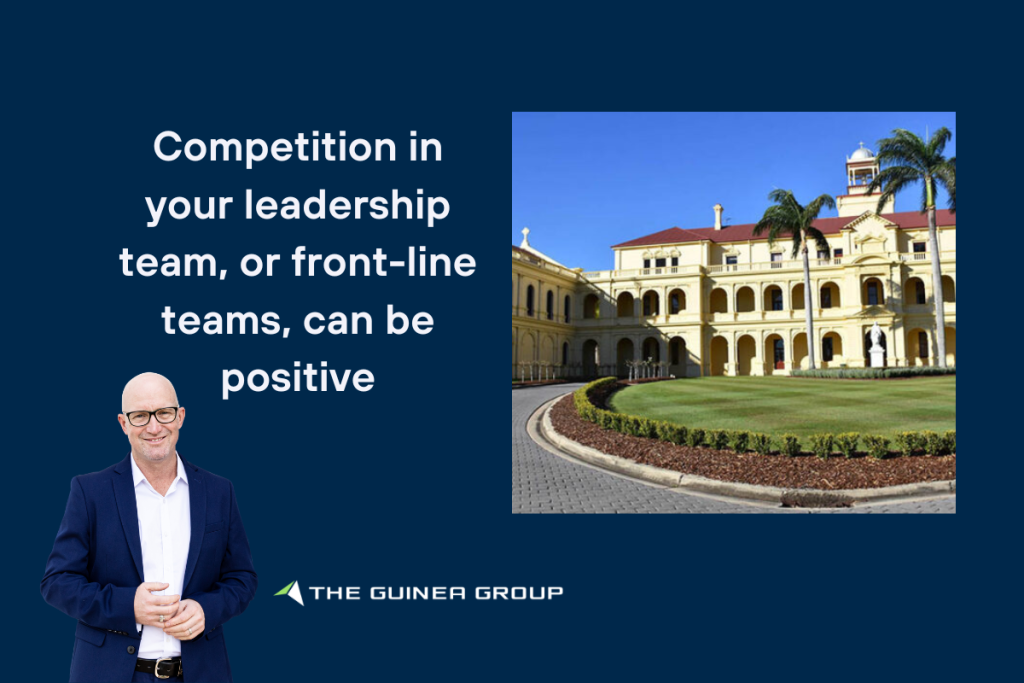Anton Guinea
Entrepreneur, Speaker, bestselling author, and founder of The Guinea Group of Companies. For over 15 years, Anton has helped leaders move their teams to become psychologically safe, physically safe and overall better versions of themselves.

Competition in your leadership team, or front-line teams, can be positive

The year was 1891, and The Congregation of Christian Brothers had an issue. The Brothers had built and ran a school (St Joseph’s) on Gregory Terrace in Brisbane city. It was an all-boys school for day scholars and for boarders.
St Joseph’s Gregory Terrace was founded in 1875, and after 16 years, they had outgrown their location, outgrown their facilities, and outgrown their capacity. So, by 1891, they needed to expand.
The Brothers found a location about 14 kilometres away, in a suburb now called Boondall. They proceeded to build a boarding school on Sandgate Road, and that school was also called St Joseph’s College. The then closest suburb was called Nudgee. So, the school got that name. St Joseph’s College, Nudgee.
Here is where this story got interesting.
Both schools were rugby union playing schools. And both were part of an association of schools called GPS (Great Public Schools). And the Gregory Terrace Campus wore, what has now become the traditional Brothers colours of, blue and white stripes. A fun fact here is that the Brother’s rugby club got those original colours from Gregory Terrace (I digress).
When the Nudgee school was built, they rightly felt entitled to adopt the blue and white stripes for their rugby team. Gregory Terrace disagreed and felt it impractical to have two schools in the same competition with the same colours (rightly so).
There was only one way to settle the dispute. And to decide on who would adopt the blue and white colours.
And that was to play a game of rugby for it, and whoever won got the colours. This game has gone down in history as the ‘Battle of the Colours’.
So, who won?
Well, 100 years after that game… (from Wiki):
“In 1991, the following was printed in the Centennial Rugby Program, dubbed – “The Battle of The Colours”, for the 100th anniversary of the annual Nudgee vs Terrace rugby match:
Before Nudgee existed, St. Joseph’s College, Gregory Terrace wore the colours Nudgee wears today – Blue and White. A popular story, especially at Nudgee, is that when Nudgee began and had to choose it colours, there was a great debate as to whether the original school, Terrace, or its “extension” school, Nudgee, should have the Blue and White. No amount of debate could solve the dispute so it was decided to rest the colour dispute on the first ever Nudgee-Terrace rugby match.
Nudgee won and Terrace then chose colours diametrically opposed. The blue became red and the white became black.
As a fun fact, the result of the Centennial Nudgee vs Terrace rugby match in 1991 was a 15-all draw.”
And the question must be considered – the two school leadership teams would have been competitive. They both wanted what was best for their school. But was it healthy competition; and can leadership team competition be healthy?
Leadership team competition (or even front-line team competition) is about measuring the performance of teams or their leaders, with very specific metrics that are relevant to a range of teams, team members, or their leaders.
Let’s unpack it.
1. Competition must be overt, not covert
A lot of our leadership training programs contain team building activities, that pit one team against each other. To build something, or make something, or draw something; quicker or higher, or better than the other teams.
And it is fun. Until it isn’t.
99% of the time it is great fun, we have a laugh, and the result is that everyone learns something, and the group comes back together for a laugh and a debrief.
The occasional times when the competition aspect of the training becomes negative is when one group doesn’t feel like they knew the rules of the game, and what they were competing for. Height or time, as an example.
The message is if you are a CEO or a senior leader, and you are comparing the performance of teams (in a positively competitive way) you need to make sure that the metrics are clear, and that everyone knows what they are. They need to be very overt. And as simple as possible. To give everyone the opportunity to achieve them.
2. Competition can be positive if it is about celebration not desolation
What I have noticed over all these years working with teams, is that when metrics are used to measure performance of two or more teams, it works best when there is a focus on celebrating success. Celebrating the team who has achieved great results.
That is not always possible, and if the same team is always the high performer, that is another discussion, but if you can get to the point where teams celebrate each other’s success without resentment or rejection.
The message is if you are a CEO or a senior leader, and you are comparing the performance of teams (in a positively competitive way) you need to find a way to help all leaders and teams to positively recognise the success of other teams. When it is warranted.
3. Competition can be positive if it is about helping, not hindering
The big challenge with competitive metrics is a win at all costs mentality. When this occurs, teams and their leaders actively do what it takes to make their own performance look good. Even if that hurts another team’s output. This can happen at the front-line level of organisations. With production or operations targets. Especially when day and night shifts are involved.
Teams develop a one-track mind, and don’t consider how by winning, they are hindering the other team’s ability to also be high performers.
The message is if you are a CEO or a senior leader, and you are comparing the performance of teams (in a positively competitive way) you need to let teams know that any behaviour that doesn’t support the organisation as a whole, won’t be rewarded. In fact, the opposite should be the case.
In summary, competition can be positive, but metrics must be overt. Success must always be celebrated, and teams must not hinder the performance of other teams.
And please click the image below if you’d like to chat about what leadership means to you.
If you would like to learn more about Anton or The Guinea Group, please click here to book into Anton’s calendar, to:
UPGRADE your Mindset
UPSKILL your Leadership
UPLIFT your Teams
About Anton
Anton has dedicated his working life to helping leaders to upgrade their mindset, upskill their leadership, and uplift their teams! With a focus on helps leaders to better lead under pressure. Anton is an entrepreneur, speaker, consultant, bestselling author and founder of The Guinea Group. Over the past 19 years, Anton has worked with over 175+ global organisations, he has inspired workplace leadership, safety, and cultural change. He’s achieved this by combining his corporate expertise, education (Bachelor of HR and Psychology), and infectious energy levels.
Work With Anton!
Subscribe to our Newsletter
